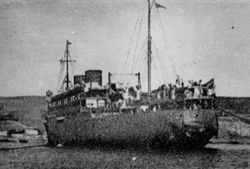Llandaff Castle
|
The identical sister ship Llangibby Castle
|
||||||||||||||||||||
|
||||||||||||||||||||
|
||||||||||||||||||||
|
||||||||||||||||||||
|
||||||||||||||||||||
|
||||||||||||||||||||
The Llandaff Castle was a passenger ship put into service in 1927 , which was used for the British shipping company Union-Castle Line in passenger and mail traffic between Great Britain and South Africa . During the Second World War , the Llandaff Castle served as a troop transport until it was sunk by a German submarine on November 30, 1942 off the coast of Mozambique .
The ship
The 10,799 GRT steamship Llandaff Castle was built at the Workman, Clark and Company shipyard in Belfast , Northern Ireland , and was launched there on August 10, 1926. She was the middle of three sister ships that the Union-Castle Line put into service in the second half of the 1920s. The Llandovery Castle (II) (10,640 GRT), which was built at Barclay, Curle and Company in Glasgow , had already been commissioned in 1925 and the Llangibby Castle (11,951 GRT), which was built by Harland & Wolff , followed in 1929. The Llandaff Castle was completed in January 1927 and shortly thereafter ran out on its maiden voyage.
The 143.6 meter long and 18.8 meter wide passenger and mail ship had a chimney, two masts and two propellers and was propelled by two quadruple expansion steam engines that developed 1,086 nominal horsepower and could accelerate the ship to 14 knots. She was one of the last ships of the shipping company that was still powered by steam engines. The era of motor ships was already beginning.
In 1940 the Llandaff Castle was the first ship to bring children evacuated from Great Britain to South Africa (see main article Children's Overseas Reception Board ). She was then requested by the British Admiralty as a troop transport . She carried troops to East Africa and the Middle East . At the beginning of 1942 the ship was extensively rebuilt so that from then on it could transport 1150 soldiers. On May 5, 1942, took part in the Allied occupation of Madagascar ( Operation Ironclad ).
Sinking
On November 26, 1942, the Llandaff Castle ran under the command of Captain Cornwallis Jasper Clutterbuck, OBE , with passengers and cargo in Dar es Salaam (Tanzania). The ship had previously come from Mombasa and was on its way to Durban . On board were 159 crew members, four gunners and 150 passengers, including six Soviet diplomats with wives and children and 70 officers with families. 300 tons of freight were also loaded. The Llandaff Castle drove without an escort .
On the afternoon of November 30, 1942, the Llandaff Castle was attacked southeast of Lourenço Marques (today Maputo ) by the German submarine U 177 (Kapitänleutnant Robert Gysae ). At 5.29 p.m. the ship was hit by two torpedoes , which were followed by fishing shots at 5.47 p.m. and 6.09 p.m. , whereupon the ship sank (position 27.20S / 33.40E). Three crew members died. Gysae appeared next to the survivors and asked them the name of the ship. They answered Hardship and Queen Mary . Next, the submarine commander asked if there were any casualties. The castaways told him that they were "just wet". U 177 then turned away.
The 310 survivors then spent two days on the open sea and were rescued on December 2, 1942 by the destroyer escort Catterick (Lt. Alexander Tyson, RN ) and brought to Durban. The Llandaff Castle was the largest ship sunk by U 177 .
